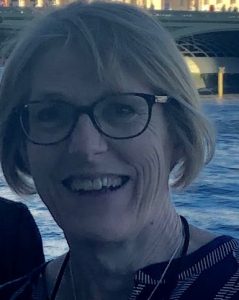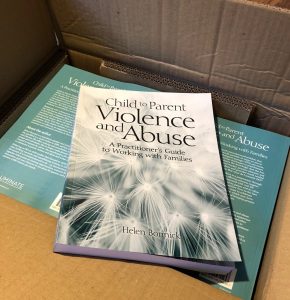I “fell into” working in the field of child to parent violence (CPV) around fifteen years ago. I had just completed some research around how parents could access help when they experienced abuse; and had done what so many others have apparently done and since reported to me – become obsessed! I felt completely driven to raise awareness of this issue, and of the unmet needs of families: speaking at conferences, lobbying for its inclusion in radio programmes and other media. In 2011 I established my website, Holes In The Wall, which now acts as an international resource hub for practitioners and academics as well as anyone else interested. In 2019 I finally achieved my goal of writing, and having published, a practitioner’s guide for those engaged in work in the field – in response to the frequent requests of both practitioners and parents. Now my husband is looking forward to retirement, I am starting to slow down, but it all still feels so important!
One of the first things I learnt was how hard it is to get your head around this issue. Talking with friends meant having to explain over and over again, “no – not abuse from parents, abuse to parents.” If I went away for a week, when I came back to it I found m yself wondering if I had got it all wrong, or was exaggerating things even. But no, what is more likely we are discovering is that the people we know of are just the tip of the iceberg. Now when I present at a conference, someone will always come up to me afterwards to seek advice. I am contacted regularly through my website or twitter by parents, or on behalf of parents. And at a recent party at our house, I knew that over ten of the families there were affected directly by violence and abuse from their children.
One of the reasons we don’t tend to know about this (apart from the lack of an officially agreed name or definition!) is of course the shame. It can be deeply humiliating to admit to being abused by someone you are expected to have authority over. But this is added to by the blame. It is as if we have a deep need to establish who is responsible for everything that goes wrong, in our battle to make sense of the world we live in. Read the comments after any report of CPV in the media, and you will be shocked by how vitriolic some people can be in asserting that parents just need to toughen up, put in boundaries, be consistent, give a good whopping. This comes from a place of deep ignorance, but it is no less powerful for that, and it echoes the views, albeit expressed less aggressively, of friends and family who see part, but not all of the problem. Indeed it is not so long ago that the government asserted, as part of the
Respect agenda, that parents would be held responsible in law for the actions of their children in an attempt to encourage greater responsibility and “better citizenship”. But there is too a notion that parents, particularly mothers, will always hold themselves to blame when it comes to their children. I spent a great deal of time talking to a journalist one day about the many different routes and issues that may be associated with CPV, but at the end she simply said that she still felt it must be her fault, because somehow she was to blame for each of those as well. When feelings are so deeply embedded, and reinforced constantly, it is hard to see how we, whether as individuals or as a society, can break out and refuse to accept that blame.
A small thing that can help the rest of us, I have found, is to use an understanding of how CPV can develop that incorporates many different levels of influence. The child themselves brings their personality, as well as their medical circumstances, but they are born into a family and a relationship with their primary care giver. That will be supported, or otherwise, by other family members and by friends with their own particular circumstances, all of whom exist within a local neighbourhood of services and provision. Wider communities start to bring their own cultural rules and assumptions, but they too exist within a society governed by politicians who drive an agenda and funding, and have power to uphold narratives about responsibility. At any point, things can go badly, or well. They can be different for children within the same family, or over time.
I would not presume to expect a parent to take this in. Perhaps they might, over time, but other professional help may be more useful or necessary in working this through. But if I can help others, including professionals, to move away from a binary understanding of blame as they try to get their heads around a new and unexpected phenomenon, and to work out how this has come about and how families can be helped,  then I will be pleased to have made an important contribution to the debate – and I will retire happy!
then I will be pleased to have made an important contribution to the debate – and I will retire happy!
Helen Bonnick
February 2020
